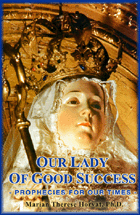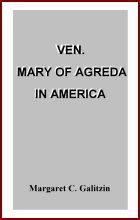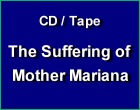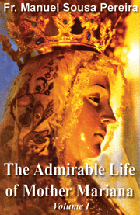What People Are Commenting
Holy Thorn of Andria & Fr. Margil
Hello,
Good morning, my name is P.J. from Nacogdoches, Texas. This year we are celebrating the 300th anniversary of the arrival of Father Margil and the other missionaries to our area in 1716.
We hope to have a reenactment of the event this July on the dates the missions were actually founded and are trying to determine the color of the robes that were worn by the friars at the time. Everything I see in old paintings looks brown, but one of our committee members says that it was blue.
Can you, please, help us clarify this question? I would also welcome any advice as we are floundering in our attempts to be historically correct.
Thank you,
P.A.J.
Dr. Horvat responds:
Hello P.A.J.,
I was pleased to learn there will be a celebration of the 300th anniversary of the Franciscans arrival to Texas.
According to the Texas State Historical Association, there were basically three divisions in the Franciscan friars who came to New Spain to establish convents and colleges, convert the natives or live the cloistered life, and each had its own color of habit:
1. The Franciscan Observants in a province, which comprised a number of convents or friaries in a certain area and were under the jurisdiction of a minister provincial, had a habit of a bluish color. No fewer than six provinces were established in Mexico between 1534 and 1606.
2. The Franciscan Observants in the missionary colleges, of which seven were founded in Mexico between 1683 and 1860, did not belong to a province, but were the equivalent of a small province. Each consisted of only one large convento or colegio, governed by a Father Guardian. The colleges ceased to exist in the latter part of the 19th century. The members of the colleges wore a grey Franciscan habit.
3. The Discalced Franciscans, a stricter reformed group, had a habit that was light brown. Their province was in San Diego in Mexico, which was founded in 1599.
Since Ven. Antonio Margil was first stationed at the missionary college of Santa Cruz, Queretaro, he would have worn the grey habit. Later, in 1722 he was elected Father Guardian of his college.
By the way, it seems that, between the late 16th and 18th centuries, the prevailing color of habit for almost all the Observant Franciscans, except the Discalced, was grey. In fact, this use of grey was so prevalent that they were known as the “grey friars.”
In 1897, Pope Leo XIII reunited the Discalced, Reformed and Recollected Franciscans with the Observants in one single Order of Friars Minor. Dark brown was made the common color of the habit of all its members.
I hope this is of help to you in your reenactment event.
Cordially,
Dr. Marian T. Horvat
Good morning, my name is P.J. from Nacogdoches, Texas. This year we are celebrating the 300th anniversary of the arrival of Father Margil and the other missionaries to our area in 1716.
We hope to have a reenactment of the event this July on the dates the missions were actually founded and are trying to determine the color of the robes that were worn by the friars at the time. Everything I see in old paintings looks brown, but one of our committee members says that it was blue.
Can you, please, help us clarify this question? I would also welcome any advice as we are floundering in our attempts to be historically correct.
Thank you,
P.A.J.
______________________
Dr. Horvat responds:
Hello P.A.J.,
I was pleased to learn there will be a celebration of the 300th anniversary of the Franciscans arrival to Texas.
According to the Texas State Historical Association, there were basically three divisions in the Franciscan friars who came to New Spain to establish convents and colleges, convert the natives or live the cloistered life, and each had its own color of habit:
1. The Franciscan Observants in a province, which comprised a number of convents or friaries in a certain area and were under the jurisdiction of a minister provincial, had a habit of a bluish color. No fewer than six provinces were established in Mexico between 1534 and 1606.
2. The Franciscan Observants in the missionary colleges, of which seven were founded in Mexico between 1683 and 1860, did not belong to a province, but were the equivalent of a small province. Each consisted of only one large convento or colegio, governed by a Father Guardian. The colleges ceased to exist in the latter part of the 19th century. The members of the colleges wore a grey Franciscan habit.
3. The Discalced Franciscans, a stricter reformed group, had a habit that was light brown. Their province was in San Diego in Mexico, which was founded in 1599.
Since Ven. Antonio Margil was first stationed at the missionary college of Santa Cruz, Queretaro, he would have worn the grey habit. Later, in 1722 he was elected Father Guardian of his college.
By the way, it seems that, between the late 16th and 18th centuries, the prevailing color of habit for almost all the Observant Franciscans, except the Discalced, was grey. In fact, this use of grey was so prevalent that they were known as the “grey friars.”
In 1897, Pope Leo XIII reunited the Discalced, Reformed and Recollected Franciscans with the Observants in one single Order of Friars Minor. Dark brown was made the common color of the habit of all its members.
I hope this is of help to you in your reenactment event.
Cordially,
Dr. Marian T. Horvat

Posted April 5, 2016


















I was surfing on the Internet a few days ago and I found the news report below in French (original here) telling about the miracle that took place in the Basilica of Saint Nicolas in Andria, Southern Italy, when the day of the Annunciation & Incarnation (March 25) coincides with Good Friday, as it did this year. In that city there is a Thorn from the Holy Crown of Thorns that the Jews and Romans pounded onto the Sacred Head of Our Lord Jesus Christ as an object of torture.
When the two holy days come on the same day, that Thorn assumes the bloody color it would have had on that first Good Friday.
The two dates also coincided in 2005 and the miracle took place; therefore, this year the authorities prepared for the eventuality it would occur again. A commission of experts with cameras – one to register the chemical variations in the Thorn, another to record the chromatic changes that could occur – were there to document the miracle.
The article reports the conclusions of this commission.
I also am sending you some photos and videos (in Italian) of the occurrence so that you can see many witnesses verifying that the miracle took place. The last video, the longer one, also provides us with a glimpse of the traditional ceremonies that still take place today in some small cities of Southern Italy. I thought you and your readers would enjoy seeing the Catholic spirit alive amid those populations.
Keep up the good work. I am a daily reader of your website.
In Jesus and Mary,
M.C.
Click here for the videos: small, medium, large.
Francesca de Villasmundo
March 29, 2016 - Andria, a small medieval city in Southern Italy, near Bari, has been granted the immense privilege since the 14th century of conserving in its cathedral a precious relic of the Passion of Christ: a Thorn from the Holy Crown of Thorns that was forced onto the head of Our Savior on Good Friday.
This sacred and venerated Thorn has a special miracle associated with it: The traces of blood, of different sizes, visible on its surface become deep red when the feast of the Annunciation on March 25 coincides with Good Friday.
The prodigy took place on March 25, 2005, the day of Good Friday. This year of 2016, when it was announced that the Incarnation of Our Lord and the Death of Jesus on the Cross are again commemorated on the same day, the high expectancy that the prodigy would take place was not in vain.
The news agency SIR (Service Information Religious) confirmed that on March 26, 2016 the miracle occurred and was verified in the presence of a notary. A diocesan notice released last night reports that, in the presence of notary Paolo Porziotta, these events took place:
“At 7:00 pm last night, the Special Commission of the Holy Thorn met in the Chapter of the Cathedral of Andria. At 4:10 pm it verified the presence a light spherical swelling of a white color, like a bud, at the distance of 3 millimeters from the tip on the right of the Thorn, more precisely on the notch at the top.
“Successively, at 5:10 pm, a second bud could be seen at the tip of the Thorn, and a third bud 4 to 5 millimeters under the first; below that, close to the base of the Thorn, the residue of blood from the miracle in the year 2005 seemed to re-blossom. All this has been precisely verified at 5:40 pm by the Special Commission and by Bishop Raffaele Calabro, who, during the homily in the liturgical celebration of Good Friday, announced to the faithful: ‘Under the circumstances, I am pleased to solemnly announce that the miracle has commenced.”
“’This is a sign by which the Lord wants to remind us of the meaning of His Passion and Death so that we may participate in His Resurrection.’”
From top down: First row, the reliquary with the Holy Thorn as it is normally seen in the Basilica; second row, the commission of experts and technicians; third row, as the miracle commences, the blood red color can be seen with the naked eye; fourth row, the Thorn one hour later; fifth row, the Thorn before the miracle as caught by a high resolution camera that registers chromatic variations; sixth row, the miracle as seen at its peak captured by the same camera.